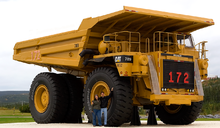|
Haul truck Haul trucks are off-road, heavy-duty dump trucks specifically engineered for use in high-production mining and exceptionally demanding construction environments. Most are dual axle; at least two examples of tri-axles were made in the 1970s. Haul trucks are denominated by their payload capacity, by weight (variously in tons, tonnes, and kg). Description  Most haul trucks have a two-axle design, but two well-known models from the 1970s, the 350T Terex Titan and 235T WABCO 3200/B, had three axles. [2] Haul truck capacities range from 40 short tons (36.3 t; 35.7 long tons) to nearly 500 short tons (454 t; 446 long tons). An example on the smaller end is the Caterpillar 775 (rated at 70 short tons [62 long tons]).[3] Quarry operations (which produce payloads that have value) are typically employ smaller trucks[why?] than mining operations (such as removing undesirable overburden, an expense).[citation needed] Haul trucks can generally be distinguished from standard dump trucks by:
Most large haul trucks use some form of traction motors coupled to regenerative brakings for power, braking, or both. Haul trucks are classified by:
Ultra class The largest, highest-payload-capacity haul trucks are referred to as ultra class trucks. The ultra class includes all haul trucks with a payload capacity of 300 short tons (270 long tons) or greater.[4] As of October 2013[update], the BelAZ 75710 has the highest payload capacity, 450 metric tons (440 long tons; 500 short tons).[5]
Notable examples
See alsoLook up long haul in Wiktionary, the free dictionary. Notes
ReferencesWikimedia Commons has media related to Haul trucks.
|





